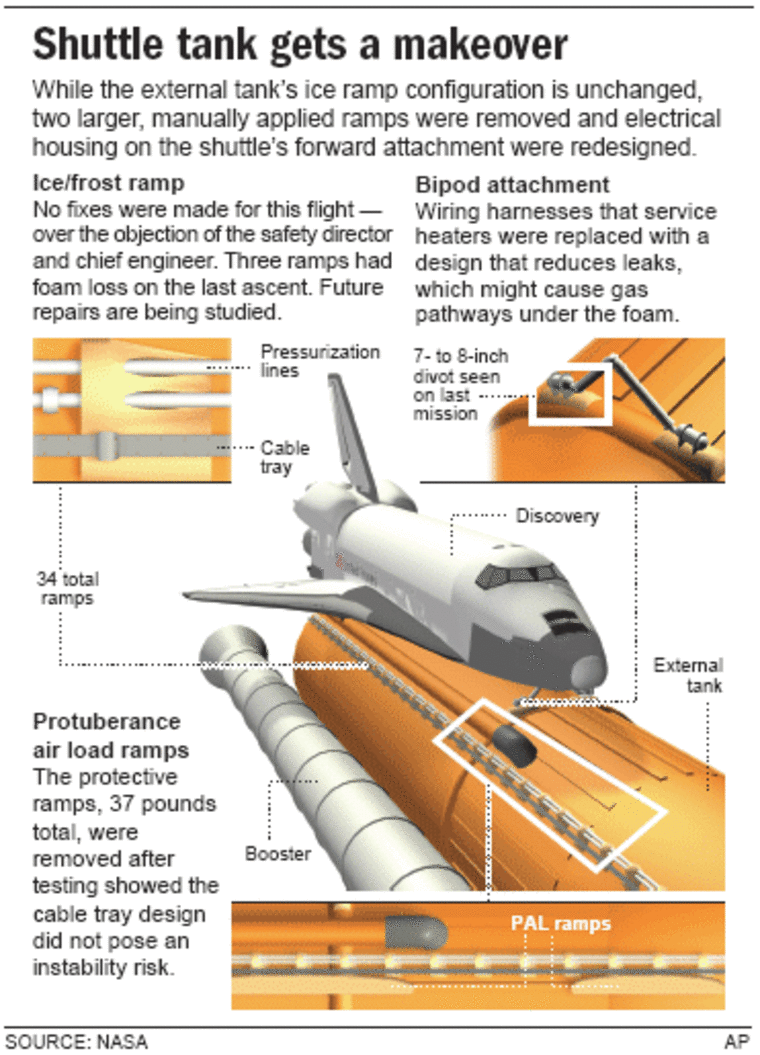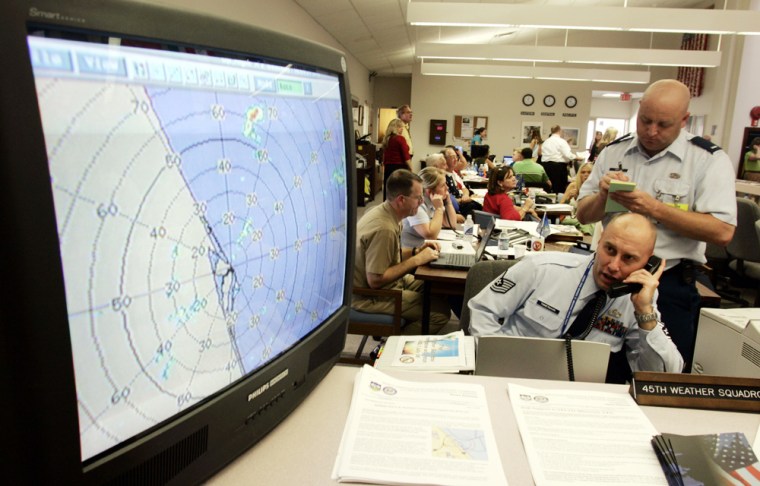CAPE CANAVERAL, Fla. - NASA managers figured out a way around a technical glitch during Saturday's countdown toward the shuttle Discovery's launch, but were frustrated by an old foe: Florida's changeable summer weather.
Threatening clouds forced a 24-hour postponement of the launch, leaving Discovery's seven astronauts in their seats as they waited for liftoff.
When mission managers told Discovery commander Steve Lindsey that the launch was off for the day, the astronaut replied, "We'll launch when we're ready, and hopefully tomorrow will look better."
Sunday's prime time for launch comes at 3:26 p.m. ET. However, forecasters said they expected the weather outlook to worsen for Sunday and Monday.
"It's frustrating — it's central Florida weather," said Tech. Sgt. Matt Timmermann of the 45th Space Wing's Weather Squadron.
NASA held the count at T-minus-9 minutes in hopes that the weather would clear, but a threatening anvil cloud drifted within 23 miles of Kennedy Space Center's landing strip — a violation of flight rules — and was heading within 12 miles of the launch pad itself, an even more serious violation.
The anvil clouds spun off by Florida thunderstorms are unwelcome because they hold an electrical charge and could actually trigger lightning during a shuttle launch, Timmermann explained. Such an event occurred during the Apollo 12 launch in 1969, and although no lasting damage was done in that case, NASA wants to avoid a repeat.
The weather bounced between "go" and "no-go" all day, primarily due to anvil clouds, and NASA launch director Mike Leinbach said it was clear in the last 20 minutes of the countdown "that we weren't going to get there today."
It took more than an hour after the scrub was announced for NASA's launch-pad team to put the shuttle into safe mode and help the last of Discovery's astronauts out of the orbiter.
Five minutes a day
The main objectives of Discovery's 12-day mission are to test safety improvements developed since its flight last year, deliver supplies to the international space station and drop off a third crew member for the station, German astronaut Thomas Reiter.
The shuttle could theoretically lift off any day between now and July 19 — but on each day, the launch opportunity effectively lasts just five minutes. (It's actually 10 minutes, but NASA generally targets just the last five.)
The reason for the short time frame is that NASA wants to launch Discovery during daylight, so that scores of cameras can monitor any debris flying off the shuttle's external fuel tank. And there's only one brief daylight opportunity that would put Discovery in the right orbital position to catch up with the space station two days after launch, as scheduled.
Technical issue addressed
While they watched Saturday's weather, mission managers dealt with a technical issue that cropped up, involving a failed heater for one of the left-hand thrusters in Discovery's attitude control system. The thruster system is used to fine-tune the shuttle's position in orbit, as well as to dock with the station. Heaters keep the thrusters' propellants from freezing in the chill of space.
"The thruster's thermostat failed," NASA spokesman Bruce Buckingham said.
As the clock ticked down, experts at Johnson Space Center drew up a plan for managing the thruster problem in orbit, Buckingham said. If the bad heater readings persisted, the crew was cleared to take that thruster out of the mix and get by with the shuttle's other thrusters to maneuver, NASA said.
The plan would be put into effect if Discovery were to launch on Sunday, NASA said.
Uncertainties about tank foam
Whenever it begins, the most critical stage of Discovery's mission could well come in the moments after launch, when more than 100 cameras record the shuttle's ascent. NASA will be watching out for bits of foam insulation flying away from the fuel tank.
Investigators say a 1.7-pound (760-gram) chunk of flyaway foam delivered the fatal blow to the shuttle Columbia back in 2003 — leading to a breakup of the spacecraft, the death of all the astronauts aboard, and a 2 1/2-year grounding of the rest of the shuttle fleet.
NASA redesigned the tank, but during last year's launch, cameras spotted a 1-pound (450-gram) piece of foam flying off the tank and just missing Discovery's wing. That led to another round of tank redesign, including the removal of the offending section of foam. This month's launch will test the design changes made so far.

Some NASA engineers advised holding off on the launch until other potential trouble spots on the fuel tank, foam structures known as ice/frost ramps, were redesigned as well. However, NASA Administrator Mike Griffin ruled that the risks associated with the ramps were lower than the risks associated with putting off Discovery's flight. He said delaying the flight too long would force NASA to rush through the 15 other flights required to finish building the international space station by 2010, as scheduled.
Griffin told NBC's "Today" that the decision was not an easy one. "No matter which side of that position I came down on, I would have been rejecting the advice of some of our top engineers," he said Saturday. But he insisted that his decision was the right one.
Quiet atmosphere
The atmosphere surrounding this launch was much quieter than it was for Discovery's liftoff a year ago, a sign that routine is beginning to return to the space program after the trauma of the Columbia tragedy.
Vice President Dick Cheney led the list of dignitaries visiting Kennedy Space Center on Saturday — but after his brief stop, Cheney went on to the Pepsi 400 auto race in Daytona, Fla., then was due to head back to Washington. There was no immediate indication that Cheney intended to return to Florida for another launch attempt.
